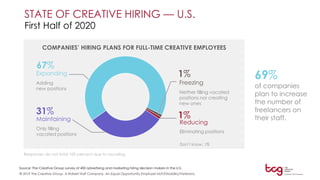
State of Creative Hiring - First Half of 2020
- 1. © 2019 The Creative Group. A Robert Half Company. An Equal Opportunity Employer M/F/Disability/Veterans. Source: The Creative Group survey of 400 advertising and marketing hiring decision makers in the U.S. STATE OF CREATIVE HIRING — U.S. First Half of 2020 69% of companies plan to increase the number of freelancers on their staff. 67% Expanding Adding new positions 31% Maintaining Only filling vacated positions 1% Freezing Neither filling vacated positions nor creating new ones 1% Reducing Eliminating positions COMPANIES’ HIRING PLANS FOR FULL-TIME CREATIVE EMPLOYEES Responses do not total 100 percent due to rounding. Don’t know: 1%
- 2. © 2019 The Creative Group. A Robert Half Company. An Equal Opportunity Employer M/F/Disability/Veterans. Source: The Creative Group survey of 400 advertising and marketing hiring decision makers in the U.S. STATE OF CREATIVE HIRING — U.S. First Half of 2020 4 3 2 1 5 Web and mobile development User experience User interface and interaction design Creative development Web production (Multiple responses were permitted. Top responses are shown.) *Denotes a tie. 6 7 8 9 10 Visual design User research Digital marketing Marketing strategy Information architecture; marketing technology; social media* TOP AREAS FOR HIRING
- 3. © 2019 The Creative Group. A Robert Half Company. An Equal Opportunity Employer M/F/Disability/Veterans. Source: The Creative Group survey of 400 advertising and marketing hiring decision makers in the U.S. STATE OF CREATIVE HIRING — U.S. Recruiting Challenges 86% of hiring decision makers say it’s challenging to find skilled creative talent today. TOP TECHNICAL SKILLS IN IMMEDIATE DEMAND (Multiple responses were permitted. Top responses are shown.) *Denotes a tie. 1. Digital strategy 2. Content creation and content marketing; social media management* 3. Artificial intelligence and machine learning 4. Data science, data analysis and A/B testing 5. User interface design
- 4. © 2019 The Creative Group. A Robert Half Company. An Equal Opportunity Employer M/F/Disability/Veterans. Source: The Creative Group survey of 400 advertising and marketing hiring decision makers in the U.S. STATE OF CREATIVE HIRING — U.S. Retention Challenges 51% of advertising and marketing managers say unexpectedly losing a highly skilled team member would have a significant, adverse impact on their business because they’d be hard to replace. 45% think they’d be stretched thin but could find a replacement for the role fairly quickly.
- 5. © 2019 The Creative Group. A Robert Half Company. An Equal Opportunity Employer M/F/Disability/Veterans. Source: The Creative Group survey of 400 advertising and marketing hiring decision makers in the U.S. 55% of hiring decision makers say they experience the most turnover among midlevel employees. STATE OF CREATIVE HIRING — U.S. Retention Challenges Entry-level (0-3 yrs’ exp.) Midlevel (4-8 yrs’ exp.) Senior-level (8+ yrs’ exp.) Executive-level 33% AT WHAT POSITION LEVEL DOES YOUR COMPANY EXPERIENCE THE MOST EMPLOYEE TURNOVER? 55% 10% 2%
- 6. © 2019 The Creative Group. A Robert Half Company. An Equal Opportunity Employer M/F/Disability/Veterans. Source: The Creative Group survey of 400 advertising and marketing hiring decision makers in the U.S. STATE OF CREATIVE HIRING — U.S. TOP STEPS COMPANIES HAVE TAKEN TO RETAIN CREATIVE AND MARKETING EMPLOYEES IN THE LAST YEAR Retention Tactics (Multiple responses were permitted. Top responses are shown.) *Denotes a tie. 1. Offered better benefits (48%) 2. Improved professional training and development (44%) 3. Increased bonuses; offered more flexible scheduling options* (43%) 4. Became more open to remote work and employee relocation opportunities (40%) 5. Raised salaries — more than we traditionally would have (39%) 7% of companies haven’t taken any steps to improve retention.
